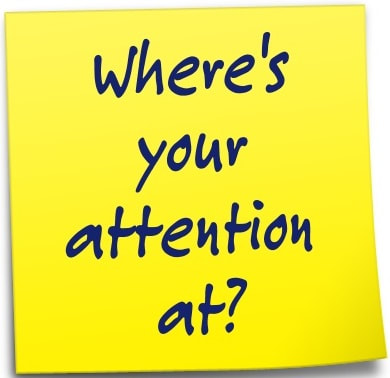|
Thanks for visiting - 2023 marks our 20th anniversary! This site is ad-free and supported by sales of our online courses. If you get value from what we write, click the link at the bottom of the page and read Day 1 of "Your inner narrative" to see if it's right for you...no email required. It's time for another installment of "Question and Answer Tuesdays!" Julie writes: "I started meditating to develop patience and not be so emotional around my husband and kids. I enjoy meditating, but to be honest it hasn't helped much with the patience and temper part. Is there a secret to moving to the next level (so to speak) where that happens?" HOW DO I GET THE BENEFITS OF MEDITATING? Behind the common misconceptions that exist about mindfulness and meditation, your question is the biggest issue for people who undertake the practice: "How do I get it to help with what's going on in my life?!?" How do you use it to reduce stress, help deal with feelings of anxiety and depression, increase focus, reduce extreme emotions, or any of the myriad of reasons that bring people to meditation? Realize that the natural state for most of us is living on autopilot - we are pushed and pulled through the day by our minds, and we aren't even aware that we're pushed and pulled through the day by our minds. In your example, your husband says or does something - your mind takes that "something," assigns a feeling of unpleasant to it, and you habitually react with aversion towards the experience that gave you unpleasant feelings. You push it away, you battle with it, you get angry about it, you feel the urge to defend yourself - to prove yourself right and someone else wrong. Or, you retreat and dwell in thoughts and emotions about how you were wronged, and let those thoughts and emotions take over and drag you into a "pit of despair." This is how your mind conditions your behavior. It puts experience through a process that starts with labeling and categorizing it, which - in turn - gives rise to thoughts, emotions, and stories that constantly run through your head and ultimately dictate "who you are" and "what you do." Using your example, "what you do" are actions that display a lack of patience and a short temper. And, "who you are" is someone who is impatient and quick to anger! The problem is, we don't see this process unfolding moment after moment after moment - it's automatic, and we just get carried along by it. Meditating can help. We define it as a dedicated exercise that allows you to develop the skill of observing your compulsive mind and non-stop mental activity without getting caught up in it. It's only half of the equation, though. The problem is most people approach meditating like a chore or another item on their "to-do list," and they never consider the other half of the equation: being mindful when they aren't meditating. And that is the answer to your question! Being mindful is applying the skill you develop while meditating to your "non-meditating time." Returning to our example above - now, instead of following you mind down a path that conditions your behavior, you can observe what your mind is doing: you can watch the feelings of "pleasant" and "unpleasant" being assigned to experience. You can see the thoughts, emotions, and stories that arise as a result. You can feel the tug to habitually react with aversion towards what you don't like and desire for what you do like. And, you can choose not to indulge any of it. Instead, you can choose to let it all be, independent of you and your attention. The simple act of strengthening awareness - so you can see the process unfolding moment after moment after moment - gives you the freedom to make this different choice. By being aware of the process, it no longer dictates "who you are" and "what you do." A simple way of representing what's discussed above is to point out that we are all in one of two states at any given time:
You want to move from the first state to the second state, and being mindful helps you do that. Which brings us to the how part of your question...how do you get to that second state (or, as you phrased it, the "next level")? Applying mindfulness (being mindful) is a function of two things:
BEING MINDFUL: THE PAUSE What tools can you utilize to be mindful when you aren't meditating? I suggest our students create a visual or audio cue to remind them to pause as they go through the day. These cues are built around the question "Where's your attention at?" Here are a few suggestions:
Anything can be a "mindfulness cue" - make a pen mark on the back of your hand! When you see or hear your cue, pause. Ask where your attention is at, and take a minute to explore the answer. Is it caught up in mind-made activity, lost in thoughts and emotions and stories? If so, bring it back to the present moment, and whatever you are doing right here and now. As you train yourself to do this, the next step is bringing it to daily situations that trigger the behavior you find unskillful. When those situations occur, make your first response be to pause. Ask where your attention is at - is it being dragged down a path fueled by labels, feelings, thoughts, emotions, and stories? If so, recognize you are now observing this activity, and - because you are aware of what's happening - you no longer have to follow it down that path. Bring your focus back to right here and now. Breathe. Explore your options. It's simple, but it does take practice. Utilize the tools - the mindfulness cues - to help you at first. Eventually you may not need them. But, if you continue to need them, that's okay. Either way, as long as you continue to work at it, you'll see results. In summary, there are two parts to the equation. Develop the skill through meditating, and apply the skill by being mindful. To see the benefits of your practice, you need to do both. <>
Our minds constantly create stories about what we experience, and we spend most of our time caught up in those stories. This results in the stress and struggles of daily life. "Your inner narrative" (our 15-day online course) can help you break that pattern. Read Day 1 here (no email required). Comments are closed.
|

